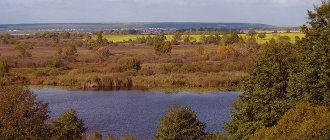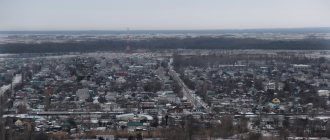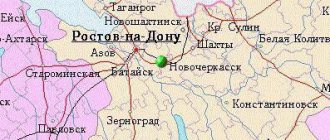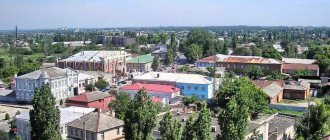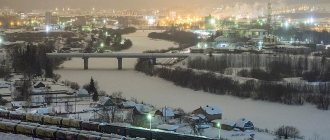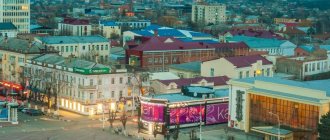Ostrogozhsk
(Voronezh region)
OKATO code:
20231501
Founded:
1652
City since:
1652 City of district subordination (Ostrogozhsky district, Voronezh region)
Center:
Ostrogozhsky district
Telephone code (reference phone)
| 47375***** | 42-2-22 |
Deviation from Moscow time, hours:
0
Geographic latitude:
50°52′
Geographic longitude:
39°04′
Altitude above sea level, meters:
110 Sunrise and sunset times of the Sun and Moon in the city of Ostrogozhsk
Literature
- Ostrogozhsk // Encyclopedic Dictionary of Brockhaus and Efron: in 86 volumes (82 volumes and 4 additional). - St. Petersburg, 1890-1907.
- Khalimonov A. D.
Ostrogozhsk. — Voronezh: Central-Chernozem. book publishing house, 1978. - 176 p. - Lappo G. M.
Cities of Russia: encyclopedia. - M.: Great Russian Encyclopedia, 1994. - P. 338-339. - Gorkin A.P.
Geography of Russia: encyclopedic dictionary. - M.: Great Russian Encyclopedia, 1998. - P. 434. - Pospelov E. M.
Geographical names of the world. Toponymic dictionary: about 5000 units. - M.: Russian dictionaries, LLC "Publishing House Astrel", LLC "Publishing House AST", 2001. - P. 315.
Map
| Ostrogozhsk: maps |
Ostrogozhsk: photo from space (Google Maps) Ostrogozhsk: photo from space (Microsoft Virtual Earth)
| Ostrogozhsk Nearest cities. Distances in km. on the map (in brackets along roads) + direction. Using the hyperlink in the distance , you can get the route (information courtesy of the AutoTransInfo website) | |||
| 1 | Krasnoe (Belgorod region) | 27 (34) | Z |
| 2 | Kamenka | 31 (30) | SE |
| 3 | Liski | 34 (44) | IN |
| 4 | Alekseevka | 37 (48) | SW |
| 5 | Repyovka | 37 (48) | NW |
| 6 | Davydovka | 41 (42) | NE |
| 7 | Novovoronezh | 51 (79) | WITH |
| 8 | Biryuch | 52 (74) | SW |
| 9 | Kolodezny | 56 (125) | WITH |
| 10 | Podgorensky | 65 (98) | SE |
| 11 | Olkhovatka | 66 (118) | YU |
| 12 | Kashirskoe | 70 (99) | NE |
| 13 | Bobrov | 71 (90) | IN |
| 14 | Khokholsky | 81 (113) | WITH |
| 15 | Rossosh | 82 (96) | SE |
| 16 | Novy Oskol | 85 (116) | Z |
| 17 | Pavlovsk | 87 (148) | SE |
| 18 | Chernyanka (Belgorod region) | 88 (103) | Z |
| 19 | New Usman | 88 (105) | WITH |
| 20 | Voronezh | 88 (121) | WITH |
| 21 | Plate | 88 (135) | WITH |
| 22 | Nizhnedevitsk | 89 (157) | NW |
| 23 | Semiluki | 90 (132) | WITH |
| 24 | Veidelevka (Belgorod region) | 90 (144) | SW |
| 25 | Vorontsovka | 94 () | IN |
| 26 | Volokonovka (Belgorod region) | 95 (136) | SW |
| 27 | Stary Oskol | 98 (104) | NW |
| 28 | Valuyki | 99 (120) | SW |
| 29 | Gorshechnoye (Kursk region) | 102 (133) | NW |
| 30 | Will | 103 () | WITH |
a brief description of
Located on the Central Russian Upland, on the river. Quiet Sosna (tributary of the Don), 3 km from the railway of the same name. station, 142 km south of Voronezh.
Territory (sq. km): 193
Information about the city of Ostrogozhsk on the Russian Wikipedia site
Historical sketch
It arose in the first quarter of the 17th century. when, on the instructions of Tsar Alexei Mikhailovich, the resettlement of Cherkasy (Ukrainians) who fled from Polish lands from religious persecution began along the banks of the Tikhaya Sosna River.
In 1652 (considered the year the city was founded), a fort was built on the Ostrogozhsky settlement in the Belgorod abatis system on the southern border of the Russian state. The fort was located at the confluence of the Tikhaya Sosna river. Ostrogoshch, named after this river. The hydronym is formed as a possessive adjective from the Old Russian personal name Ostrogost.
The city was colloquially called Rybny, since here was the main warehouse for fish exported to the inner provinces from the Don.
Cherkasy continued to move here, from which in 1664 a special Cherkasy Ostrogozh regiment was formed.
In 1696, a meeting between Peter I and Hetman Mazepa took place in Ostrogozhsk. In 1765, a hussar regiment was formed from the Ostrogozhsky Sloboda Regiment.
In 1708 it was assigned to the Azov province (from 1725 - Voronezh province), from 1719 to the Voronezh province. Since 1765, Ostrogozhsk has been a provincial town in the Sloboda-Ukrainian province. Since 1779 - a district town of the Voronezh governorship. From 1796 - in the Sloboda-Ukrainian province, from 1802 - in the Voronezh province.
In 1856, in the district town of Ostrogozhsk, Voronezh province, there were 7 churches, 761 houses, 106 shops.
Since 1873, an annual exhibition of agricultural working horses was held in Ostrogozhsk.
In 1895, the Kharkov-Balashov railway passed through Ostrogozhsk.
During the Great Patriotic War of 1941-45, Ostrogozhsk was occupied by Nazi troops on July 5, 1942. It was liberated on January 20, 1943 by troops of the Voronezh Front during the Ostrogozh-Rossoshan operation.
In 1957, the village of Novaya Sotnya (8.8 thousand inhabitants, 1939) became part of the city.
Economy
Food industry enterprises: canning, wine, butter and cheese factories; poultry plant Light industry: branches of the sewing production associations “Rabotnitsa” and “Don”, tannery.
Factories: auto repair, brick, carpentry, drying.
In the Ostrogozhsky district, grain crops, sugar beets, and sunflowers are grown. Cattle, sheep, and pigs are raised.
Deposits of chalk, sand, clay.
Culture, science, education
Museum of Local Lore. House-Museum of I.N. Kramskoy (born in Ostrogozhsk).
Art Gallery named after I.N. Kramskoy.
The poet and philosopher N.V. was born in Ostrogozhsk. Stankevich, spent his childhood with S.Ya. Marshak.
Museums, galleries, exhibition halls
House-Museum of I.N.
Kramskoy 397855, Voronezh region, Ostrogozhsky district, Ostrogozhsk, st. Marshak, 14 Phone(s): (47375) 4-20-54 Ostrogozhsky Historical and Art Museum named after. I.N. Kramskogo 397855, Voronezh region, Ostrogozhsky district, Ostrogozhsk, Kramskogo boulevard, 4 Phone(s): (47375) 4-14-81
Architecture, sights
The city has partially preserved the regular layout and row buildings of the 19th century.
| Population by year (thousands of inhabitants) | |||||||
| 1856 | 7.4 | 1979 | 34.0 | 2006 | 32.7 | 2016 | 32.8 |
| 1897 | 21.0 | 1989 | 34.5 | 2007 | 32.3 | 2017 | 32.7 |
| 1913 | 23.9 | 1992 | 34.9 | 2008 | 32.0 | 2018 | 32.6 |
| 1926 | 11 | 1996 | 36.7 | 2010 | 31.6 | 2019 | 32.3 |
| 1931 | 19.3 | 1998 | 34.7 | 2011 | 33.8 | 2020 | 31.8 |
| 1939 | 11.7 | 2000 | 33.6 | 2012 | 33.4 | 2021 | 31.5 |
| 1959 | 28.4 | 2001 | 33.0 | 2013 | 33.0 | ||
| 1967 | 33 | 2003 | 34.6 | 2014 | 32.8 | ||
| 1970 | 29.9 | 2005 | 33.4 | 2015 | 32.9 | ||
Links[edit]
Notes[edit]
- ^ abcdefgh Law No. 87-OZ
- ^ abc Federal State Statistics Service (2011). “All-Russian Population Census 2010. Volume 1" [All-Russian Population Census 2010, vol. 1]. All-Russian Population Census 2010 [All-Russian Population Census 2010]
. Federal State Statistics Service. - "26. The size of the permanent population of the Russian Federation by municipalities as of January 1, 2022". Federal State Statistics Service. Retrieved January 23, 2022.
- ^ abcde Law No. 88-OZ
- "On the Calculation of Time". Official Internet portal of legal information
. June 3, 2011. Retrieved January 19, 2022. - Post office. Information and computing center of OASU RPO. ( Post office
).
Search for postal service objects ( postal Search for objects
) (in Russian) - ↑
Federal State Statistics Service of Russia (May 21, 2004).
“The population of Russia, the constituent entities of the Russian Federation as part of federal districts, urban settlements, settlements, settlements of 3 thousand or more people” [Population of Russia, its federal districts, federal districts, districts, urban settlements, rural settlements - administrative centers and rural settlements with a population of more than 3,000 people] (XLS). All-Russian Population Census 2002
. - “All-Union Population Census of 1989. The current population of union and autonomous republics, autonomous regions and districts, territories, negative phenomena, urban settlements and rural district centers” [All-Union Population Census of 1989: current population of union and autonomous republics, Autonomous regions and districts , territories, regions, districts, towns and villages performing the functions of district administrative centers. All-Union Population Census of 1989 [All-Union Population Census of 1989]
.
Institute of Demography of the National Research University: Higher School of Economics [Institute of Demography of the National Research University: Higher School of Economics]. 1989 - via Demoscope Weekly
. - “All-Union Population Census of 1979. National composition of the population by regions of Russia” [All-Union Population Census of 1979. Ethnic composition of the population by regions of Russia] (XLS). All-Union Population Census of 1979 [All-Union Population Census of 1979]
.
1979 - via Demoscope Weekly
(website of the Institute of Demography of the State University - Higher School of Economics. - ^ a b Plokhy, Sergey, 1957-. Cossack Myth: History and Statehood in the Age of Empires
. ISBN 1-107-44903-0. OCLC 1041371688 .CS1 maint: multiple names: authors list (link) - The Russo-Turkish War, 1768–1774: Catherine II and the Ottoman Empire
. Bloomsbury Academic. 2016 DOI: 10.5040/9781474211147. ISBN 978-1-4725-1293-2. - Davis B. Russian-Turkish War, 1768-1774: Catherine II and the Ottoman Empire. London, 2016. P. 75.
- Kollmann, Nancy: Crime and Punishment in Early Modern Russia. Cambridge, 2012. P. 377.
- “Ostrogozhsk” & hl = de & sa = X & ved = 0ahUKEwiQwOSzwr_oAhUZ5KYKHe3KA1EQ6AEIRDAD # v = onepage & q = “ostrogozhsk” & f = false Plokhy S. Cossack myth: history and nationality in the era. Cambridge, 2012. P. 21.
- ^ abc Leonov, I. Ukrainian Don region
. "Young Ukraine" - photo
- "OSTROGOZK" . resource.history.org.ua
. Retrieved March 13, 2022. - ^ ab Smoliy, V.A. Ivan Dzykovsky (DZIKOVSKY IVAN) . Encyclopedia of Ukrainian History.
- Demoscope. 1897 Census
- “Ukraine is Young:.: Vidannya | Ukrainian Podonnya". January 12, 2016 archive from the original on January 12, 2016. Retrieved June 1, 2022.
- "Ostrozhye". www.encyclopediaofukraine.com
. Retrieved March 31, 2022.
Sources [edit]
- Voronezh Regional Duma. Law No. 87-OZ of October 27, 2006 “On the administrative-territorial structure of the Voronezh region and the procedure for changing it,” as amended. Law No. 41-OZ of April 13, 2015 “On amendments to the Law of the Voronezh Region” On the administrative-territorial structure of the Voronezh Region and its amendments “”. Came into force after 10 days from the date of official publication. Published: “Young Communard”, No. 123, November 3, 2006 (Voronezh Regional Duma. Law of October 27, 2006 No. 87-OZ “ On the administrative-territorial structure of the Voronezh region and the procedure for changing it”
as amended by Law No. 41 -OZ dated April 13, 2015
On amendments to the Law of the Voronezh Region “On the administrative-territorial structure of the Voronezh Region and the procedure for its amendment"
. Valid after 10 days from the date of official publication.). - Voronezh Regional Duma. Law No. 88-OZ of December 2, 2004 “On establishing boundaries, granting the status of administrative determination to the centers of the municipalities of Gribanovsky, Kashira, Ostrogozhsky, Semiluksky, Talovsky, Khokholsky negation and the city of Novovoronezh,” as amended. Law No. 77-OZ of June 4, 2015 “On amendments to certain legislative acts of the Voronezh region in connection with changes in some municipalities of the Voronezh region.” Came into force on the date of official publication. Published: “Commune”, No. 189, December 4, 2004 (Voronezh Regional Duma. Law No. 88-OZ of December 2, 2004 On establishing boundaries, assigning the appropriate status, creating administrative centers of the municipalities of Gribanovsky, Kashirsky, Ostrogozhsky, Semiluksky , Talovsky, Khokholsky districts and the city of Novovoronezh
as amended by Law No. 77-OZ of June 4, 2015
On amendments to various legislative acts of the Voronezh region in connection with changes in the boundaries of several municipalities of the Voronezh region
... Valid from the date of official publication.).
Voronezh is the only million-plus city and the largest city in the region
Voronezh, located on the river of the same name, cannot be called small: it is a real metropolis, where in 2012 the number of residents exceeded a million. The urban agglomeration is even larger: the population is about 3 million, which makes it 14th on the list of the most populated cities in Russia. With the exception of the recession of 1998-2088, the population has been increasing steadily since 1923: then the figure was only 95,000. Ten years before that, Voronezh was among the top 20 largest cities in the Russian Empire.
Despite the fact that the regional center is not spoiled by the attention of tourists, it has something to be proud of. It was here that Peter the Great built his first regular fleet, which was not only combat-ready, but also won the famous Azov victories.
Of course, Voronezh cannot “boast” of such crowds of people as in Moscow and other big cities. However, it suffers from all the typical problems of megacities: many kilometers of traffic jams, poor ecology and lack of places in kindergartens. Difficult traffic is observed on the central city streets and in the historical center, as well as at the entrances to densely populated residential areas.
It is the excess of vehicles that has the most serious negative impact on the environment: its emissions account for 90% of the total pollution indicator. There are also many industrial enterprises that pollute soil and water, including the Voronezh reservoir, one of the largest in the world located within the city. Harmful substances such as:
- zinc;
- lead;
- cadmium;
- copper.
Despite the significantly larger number of residents, compared to other settlements in the region, there are enough jobs in the capital. 2022 was a record year: the unemployment rate dropped to 3.1%. The Russian average for this period was 5%. On the other hand, the capital of the region accounts for half of the total number of all unemployed in the region. In addition, despite the stagnation of the last decade and the decline of industry, more than 30 significant enterprises make a significant contribution to the economy.
Liski is old and large by the standards of the region
Liski is one of the oldest settlements in the region, founded in 1571 as the village of Pokrovka. Over the next 300 years, the settlement developed poorly, even despite the construction of the railway and the opening of the Liski railway station near the village. In 1928, the station and the village merged, which led to the development of a new administrative unit and an increase in the number of residents. A decade later, Liski was given city status and a new name - Sloboda.
Since 2012, there has been a decline in numbers: by 2022 there has been a decrease of 3,000. People in the town are retained by a fairly developed industry: there are more than 15 enterprises. The agro-industrial complex and agriculture are well developed. Liski produces 24.8% of the regional volume of milk and 44.2% of meat products.
The largest cities in the Voronezh region by population
The region boasts the presence of 15 cities, but only one of them is considered large - the capital of the region, Voronezh. This is the only million-plus city, where 1,047,549 people live as of 2022. Paradoxically, there are no other large settlements in the region: all the rest have a population of less than 100,000. Only three, besides the capital, have more than 50,000 residents. However, you won’t find very small towns: only one of the list has a population of less than 10,000.
The most densely populated cities in the Voronezh region include:
- Voronezh - 1,047,549.
- Rossosh - 62,827.
- Borisoglebsk - 61,765.
- Liski - 53,897.
- Ostrogozhsk - 32,601.
- Novovoronezh - 31,503.
- Semiluki - 26,732.
- Pavlovsk - 24,858.
- Buturlinovka - 24,319.
- Bobrov - 20,460.

